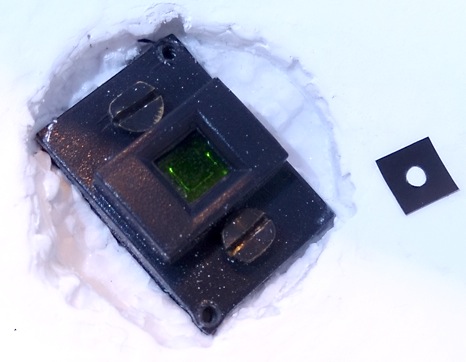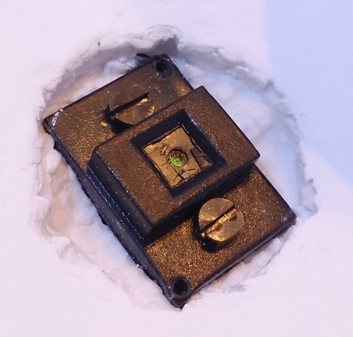Initial measurements and alterations.
1) First thing I found is that the sphere was out of range at more than about 720 lumens. So I made an aperture in front of the sensor. I did that with duct-tape, as shown above. But during the following two weeks the readings of the same lights appeared to drop slowly. I first was afraid that it was caused by yellowing of the inner coating of the sphere, but then I thought of the piece of tape. I opened the sensor area and found indeed that the tape had slowly come a bit loose by the slight tension with which it was applied. That changed the properties of the aperture slightly and caused the measurment drop. I took the tape out and replaced it by a black piece of B&W-film I had somewhere. It could move around a bit after insertion, so i sticked small pieces of film between the sides until everything was tight:



I re-assembled the sphere and from now on I had very consistent readings.
2) Before and after the bariumsulphate/latex coating I took measurements with the unfinished sphere, expecting that the reading of the sphere would increase dramatically after applying the coating, because of improved reflectivity. Well, unfortunately that was not the case, in contrary: the readings dropped by 20%. The coating looked really white though. I still can not explain why the readings should be lower with the coating, I only hope that at least the reflectivities of all wavelengths of the colour spectrum have become more equal by the coating, so that I have had at least a reason to go through the trouble of coating  .
.
3) The light output of the adjustment light appeared very very constant (as hoped and expected). I used it to measure the impact of the presence of different flashlights that were flush with the entrance hole of the sphere (the measurement position), the flaslights were off, just the adjustment light was on, so that the readings were a measure for the light sensitivity of the sphere, that is different for every 'hole-disturbance' :
50mm hole empty: 176
50mm hole with Sunwayman D40A: 191
50mm hole withConvoy M2: 183
placed the insert with 30mm hole: 203
insert with 30mm hole with Ultrafire K10: 203
insert with 30mm hole with copper led-mounting device+20mmSinkpad: 202
As you can see, the impact of 'what's in the hole' is quite large with a 50mm hole, and must be corrected. You can even measure a clear difference between two flashlights of the same head diameter, one with black bezel, one with silver bezel. When the insert with 30mm hole is put in, the impact of 'what's in the hole' becomes hardly measurable. So without the adjustment light to correct this, the sphere would suffer severely from the 50mm entrance hole size. A 50mm hole like I have here would without correction only be suitable for a larger sphere, like 40cm diameter instead of 20.
4) Based on the first rough measurements, the sphere as it is finished (with aperture) can measure up to 3300 lumen, and as low as 0.002 lumen. I like that range!
5) Linearity test of the light sensor: if you measure the adjustment light and another light separately, will the reading of the two lights switched on at the same time be equal to the added readings of the separate lights? Yes!
(with 30mm hole) adjustment light:152, UltrafireK10-mod:107, both:260
(with 50mm hole) adjustment light:135, ConvoyM2-mod:202, both:339
6) comparison between ceiling bounce measurements and IS-measurements of the same couple of lights. I have not done these tests well enough yet, initial results show a clear difference, perhaps caused by sensitivity of the ceiling bounce method to beam patterns.
7) influence of the 9V battery on the readings of the luxmeter. By accident I left the luxmeter switched on overnight (it has no auto-power-off) and was afraid that the readings would have altered. I measured the same lightsources with the old battery and a fresh one: no difference. this means that either the meter works fine with a low battery, or that it is uses so little battery power that you can leave it on for days without problems. Both outcomes are fine to me :-)
8) I had to find a suitable conversion factor from sphere readings to lumens. That conversion factor is different depending on 'what's in the hole', as shown above. For bare led measurements with the 30mm hole+ledmount I came up with 1.58 (reading times 1.58 gives lumen) ; for the 50mm hole with the SWM D40A it is 1.58*202/191=1.67 (I used the readings of the adjustment light for the correction here). I chose this conversion factor because with it the SWM D40A on high setting calculates exactly at 550 lumen, what is the output on high according to official specs of the light (very convenient, the D40A is also one of my reference lights  ). Of course different units of this light will vary, but several other measurements I did with the sphere, together with old ceiling bounce results I had also point towards round about this conversion factor. Until I have an officially exact measured lightsource this conversion factor will have to do. But don't be surprised if it is 5% or a bit more off in the end
). Of course different units of this light will vary, but several other measurements I did with the sphere, together with old ceiling bounce results I had also point towards round about this conversion factor. Until I have an officially exact measured lightsource this conversion factor will have to do. But don't be surprised if it is 5% or a bit more off in the end  .
.
This is it for now. There's tons more to measure and adjust if I want, but I won't, I am going to put the sphere into use with what I have :-)
 . In the article they said that they did not use BaSO4 because it formed cracks in the paint, but the way I used it mixed with latex paint does not produce any cracking, the coating is even slightly flexible, it survives light deformations of the styrofoam.
. In the article they said that they did not use BaSO4 because it formed cracks in the paint, but the way I used it mixed with latex paint does not produce any cracking, the coating is even slightly flexible, it survives light deformations of the styrofoam.